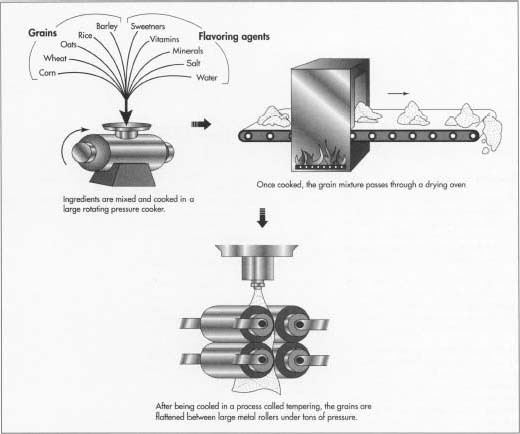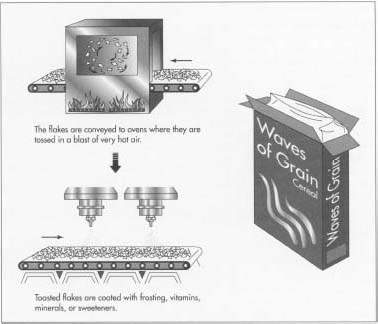Cereal
Background
Breakfast cereal is a processed food manufactured from grain and intended to be eaten as a main course served with milk during the morning meal. Some breakfast cereals require brief cooking, but these hot cereals are less popular than cold, ready-to-eat cereals.
Prehistoric peoples ground whole grains and cooked them with water to form gruels and porridges similar to today's hot cereals. Cold cereals did not develop until the second half of the nineteenth century.
Ready-to-eat breakfast cereals were invented because of religious beliefs. The first step in this direction was taken by the American clergyman Sylvester Graham, who advocated a vegetarian diet. He used unsifted, coarsely ground flour to invent the Graham cracker in 1829. Influenced by Graham, Seventh-Day Adventists, who also believed in vegetarianism, founded the Western Health Reform Institute in Battle Creek, Michigan, in the 1860s. At this institute, later known as the Battle Creek Sanitarium, physician John Harvey Kellogg invented several grain-based meat substitutes.
In 1876 or 1877, Kellogg invented a food he called granola from wheat, oats, and corn that had been mixed, baked, and coarsely ground. In 1894, Kellogg and his brother W. K. Kellogg invented the first precooked flaked cereal. They cooked ground wheat into a dough, then flattened it between metal rollers and scraped it off with a knife. The resulting flakes were then cooked again and allowed to stand for several hours. This product was sold by mail order as Granose for 15 cents per 10-ounce (284 g) package.
Both W. K. Kellogg and C. W. Post, a patient at the sanitarium, founded businesses to sell such products as health foods. Their success led dozens of imitators to open factories in Battle Creek between 1900 and 1905. These businesses quickly failed, while Kellogg and Post still survive as thriving manufacturers of breakfast cereals.
Their success can be partially attributed to advertising campaigns, which transformed the image of their products from health foods to quick, convenient, and tasty breakfast foods. Another factor was the fact that Kellogg and Post both manufactured corn flakes, which turned out to be much more popular than wheat flakes. Breakfast cereals have continued to increase in popularity in the twentieth century. Ready-to-eat breakfast cereals are served in nine out of 10 American households.
Raw Materials
The most important raw material in any breakfast cereal is grain. The grains most commonly used are corn, wheat, oats, rice, and barley. Some hot cereals, such as plain oatmeal, and a few cold cereals, such as plain shredded wheat, contain no other ingredients. Most breakfast cereals contain other ingredients, such as salt, yeast, sweeteners, flavoring agents, coloring agents, vitamins, minerals, and preservatives.
The sweeteners used in breakfast cereals include malt (obtained from barley), white sugar, brown sugar, and corn syrup. Some natural cereals are sweetened with concentrated fruit juice. A wide variety of flavors may be added to breakfast cereals, including chocolate, cinnamon and other spices, and fruit flavors. Other ingredients added to

Vitamins and minerals are often added to breakfast cereals to replace those lost during cooking. The most important of these is vitamin B-i, 90 % of which is destroyed by heat. The antioxidants BHA and BHT are the preservatives most often added to breakfast cereals to prevent them from becoming stale and rancid.
The Manufacturing
Process
Preparing the grain
- 1 Grain is received at the cereal factory, inspected, and cleaned. It may be used in the form of whole grains or it may require further processing. Often the whole grain is crushed between large metal rollers to remove the outer layer of bran. It may then be ground more finely into flour.
- 2 Whole grains or partial grains (such as corn grits) are mixed with flavoring agents, vitamins, minerals, sweeteners, salt, and water in a large rotating pressure cooker. The time, temperature, and speed of rotation vary with the type of grain being cooked.
-
3 The cooked grain is moved to a conveyor belt, which passes through a drying oven. Enough of the water remains in the cooked grain to result in a soft, solid mass which can be shaped as needed.

- 4 If flour is used instead of grains, it is cooked in a cooking extruder. This device consists of a long screw within a heated housing. The motion of the screw mixes the flour with water, flavorings, salt, sweeteners, vitamins, minerals, and sometimes food coloring. The screw moves this mixture through the extruder, cooking it as it moves along. At the end of the extruder, the cooked dough emerges as a ribbon. A rotating knife cuts the ribbon into pellets. These pellets are then processed in much the same way as cooked grains.
Making flaked cereals
- 5 The cooked grains are allowed to cool for several hours, stabilizing the moisture content of each grain. This process is known as tempering. The tempered grains are flattened between large metal rollers under tons of pressure. The resulting flakes are conveyed to ovens where they are tossed in a blast of very hot air to remove remaining moisture and to toast them to a desirable color and flavor. Instead of cooked grains, flakes may also be made from extruded pellets in a similar manner.
Making puffed cereals
- 6 Cereals may be puffed in ovens or in so-called "guns." Oven-puffed cereals are usually made from rice. The rice is cooked, cooled, and dried. It is then rolled between metal rollers like flaked cereals, but it is only partially flattened. This process is known as bumping. The bumped rice is dried again and placed in a very hot oven which causes it to swell.
- 7 Gun-puffed cereals may be made from rice or wheat. The rice grains require no pretreatment, but the wheat grains must be treated to partially remove the outer layer of bran. This may be done by abrading it off between grindstones, a process known as pearling. It may also be done by soaking the wheat grains in salt water. The salt water toughens the bran, which allows it to break off in large pieces during puffing. The grain is placed in the gun, a small vessel which can hold very hot steam and very high pressure. The gun is opened quickly to reduce the pressure suddenly, which puffs the grain. Extruded pellets can also be used to make gun-puffed cereals in the same way as grains.
Making shredded cereals
- 8 Shredded cereals are usually made from wheat. The wheat is cooked in boiling water to allow moisture to fully penetrate the grain. The cooked grain is cooled and allowed to temper. It is then rolled between two metal rollers. One roller is smooth and the other is grooved. A metal comb is positioned against the grooved roll with a tooth inside each groove. The cooked grain is shredded by the teeth of the comb and drops off the rollers in a continuous ribbon. A conveyor belt catches the ribbons from several pairs of rollers and piles them up in layers. The layers of shredded wheat are cut to the proper size, then baked to the desired color and dryness. Shredded cereals may also be made in a similar way from extruded pellets.
Making other cereals
- 9 Cereals can be made in a wide variety of special shapes (circles, letters of the alphabet, etc.) with a cooking extruder. A die is added to the end of the extruder which forms a ribbon of cooked dough with the desired cross-section shape. A rotating knife cuts the ribbon into small pieces with the proper shape. These shaped pieces of dough are processed in a manner similar to puffing. Instead of completely puffing, however, the pieces expand only partially in order to maintain the special shape.
- 10 Granolas and similar products are made by mixing grain (usually oats) and other ingredients (nuts, fruits, flavors, etc.) and cooking them on a conveyor belt which moves through an oven. The cooked mixture is then crumbled to the desired size. Hot cereals are made by processing the grain as necessary (rolling or cutting oats, cracking wheat, or milling corn into grits) and partly cooking it so the consumer can cook it quickly in hot water. Salt, sweeteners, flavors, and other ingredients may or may not be added to the partly cooked mixture.
Adding coatings
- 11 After shaping, the cereal may be coated with vitamins, minerals, sweeteners, flavors such as fruit juices, food colors, or preservatives. Frosting is applied by spraying a thick, hot syrup of sugar on the cereal in a rotating drum. As it cools the syrup dries into a white layer of frosting.
Packaging
- 12 Some cereals, such as shredded wheat, are fairly resistant to damage from moisture. They may be placed directly into cardboard boxes or in cardboard boxes lined with plastic. Most cereals must be packaged in airtight, waterproof plastic bags within cardboard boxes to protect them from spoiling.
- 13 An automated machine packages the cereal at a rate of about 40 boxes per minute. The box is assembled from a flat sheet of cardboard, which has been previously printed with the desired pattern for the outside of the box. The bottom and sides of the box are sealed with a strong glue. The bag is formed from moisture-proof plastic and inserted into the box. The cereal fills the bag and the bag is tightly sealed by heat. The top of the box is sealed with a weak glue which allows the consumer to open it easily. The completed boxes of cereal are packed into cartons which usually hold 12, 24, or 36 boxes and shipped to the retailer.
Quality Control
Every step in the manufacturing of breakfast cereal is carefully monitored for quality. Since cereal is a food intended for human consumption, sanitation is essential. The machines used are made from stainless steel, which can be thoroughly cleaned and sterilized with hot steam. Grain is inspected for any foreign matter when it arrives at the factory, when it is cooked, and when it is shaped.
To ensure proper cooking and shaping, the temperature and moisture content of the cereal is constantly monitored. The content of vitamins and minerals is measured to ensure accurate nutrition information. Filled packages are weighed to ensure that the contents of each box is consistent.
In order to label boxes with an accurate shelf life, the quality of stored cereal is tested over time. In order to be able to monitor freshness over a reasonable period of time, the cereals are subjected to higher than normal temperatures and humidities in order to speed up the spoiling process.
The Future
Breakfast cereal technology has advanced greatly since its origins in the late nineteenth century. The latest innovation in the industry is the twin-screw cooking extruder. The two rotating screws scrape each other clean as they rotate. This allows the dough to move more smoothly than in an extruder with only one screw. By using a twin-screw extruder, along with computers to precisely control temperature and pressure, cereals that usually require about 24 hours to make may be made in as little as 20 minutes.
Where to Learn More
Books
Bruce, Scott, and Bill Crawford. Cerealizing America: The Unsweetened Story of American Breakfast Cereal. Faber and Faber, 1995.
Fast, Robert B., and Elwood F. Caldwell, eds. Breakfast Cereals and How They Are Made. American Association of Cereal Chemists, 1990.
Periodicals
Dworetzky, Tom. "The Churn of the Screw." Discover, May 1988, pp. 28-29.
Fast, R. B. "Breakfast Cereals: Processed Grains for Human Consumption." Cereal Foods World, March 1987, pp. 241-244.
Other
Kellogg Company."How Kellogg's® Cereal is Made." December 4, 1996. http://kelloggs.com/booth/cereal.html (July 9, 1997).
— Rose Secrest